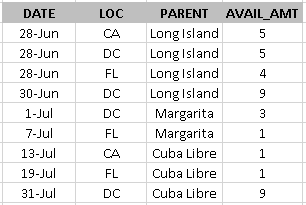In the below example, I'm trying to count the number of drinks I can make based on the availability of ingredients per bar location that I have.
To further clarify, as seen in the below example: based on the figures highlighted in the chart below; I know that I can only make 1 Margarita on 6/30/2018 (in either DC or FL if I ship the supplies to the location).
Sample of data table
Please use the below code to enter the relevant data above:
CREATE TABLE #drinks
(
a_date DATE,
loc NVARCHAR(2),
parent NVARCHAR(20),
line_num INT,
child NVARCHAR(20),
avail_amt INT
);
INSERT INTO #drinks VALUES ('6/26/2018','CA','Long Island','1','Vodka','7');
INSERT INTO #drinks VALUES ('6/27/2018','CA','Long Island','2','Gin','5');
INSERT INTO #drinks VALUES ('6/28/2018','CA','Long Island','3','Rum','26');
INSERT INTO #drinks VALUES ('6/26/2018','DC','Long Island','1','Vodka','15');
INSERT INTO #drinks VALUES ('6/27/2018','DC','Long Island','2','Gin','18');
INSERT INTO #drinks VALUES ('6/28/2018','DC','Long Island','3','Rum','5');
INSERT INTO #drinks VALUES ('6/26/2018','FL','Long Island','1','Vodka','34');
INSERT INTO #drinks VALUES ('6/27/2018','FL','Long Island','2','Gin','14');
INSERT INTO #drinks VALUES ('6/28/2018','FL','Long Island','3','Rum','4');
INSERT INTO #drinks VALUES ('6/30/2018','DC','Margarita','1','Tequila','6');
INSERT INTO #drinks VALUES ('7/1/2018','DC','Margarita','2','Triple Sec','3');
INSERT INTO #drinks VALUES ('6/29/2018','FL','Margarita','1','Tequila','1');
INSERT INTO #drinks VALUES ('6/30/2018','FL','Margarita','2','Triple Sec','0');
INSERT INTO #drinks VALUES ('7/2/2018','CA','Cuba Libre','1','Rum','1');
INSERT INTO #drinks VALUES ('7/8/2018','CA','Cuba Libre','2','Coke','5');
INSERT INTO #drinks VALUES ('7/13/2018','CA','Cuba Libre','3','Lime','14');
INSERT INTO #drinks VALUES ('7/5/2018','DC','Cuba Libre','1','Rum','0');
INSERT INTO #drinks VALUES ('7/19/2018','DC','Cuba Libre','2','Coke','12');
INSERT INTO #drinks VALUES ('7/31/2018','DC','Cuba Libre','3','Lime','9');
INSERT INTO #drinks VALUES ('7/2/2018','FL','Cuba Libre','1','Rum','1');
INSERT INTO #drinks VALUES ('7/19/2018','FL','Cuba Libre','2','Coke','3');
INSERT INTO #drinks VALUES ('7/17/2018','FL','Cuba Libre','3','Lime','2');
INSERT INTO #drinks VALUES ('6/30/2018','DC','Long Island','3','Rum','4');
INSERT INTO #drinks VALUES ('7/7/2018','FL','Cosmopolitan','5','Triple Sec','7');
The expected results are as follows:
Please note, as seen in the expected results, children are interchangeable. For example, on 7/7/2018 Triple Sec arrived for the drink cosmopolitan; however because the child is also rum, it changes the availability of Margaritas for FL.
Also not the update to the DC region for Cuba Libre's on both 06/30 and 06/31.
Please take into consideration that parts are interchangeable and also that each time a new item arrives it makes available any item previously now.
Lastly - It would be awesome if I could add another column that shows kit availability regardless of location based only on availability of the child. For Ex. If there is a child #3 in DC and none in FL they FL can assume that they have enough inventory to make drink based on inventory in another location!



28-Jun CA Long Island 7in the first row of expected result? b) What's the role of child? – Letriceline_numis 5. Are there other 4 children ofcosmopolitan? – Letrice